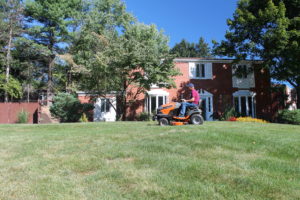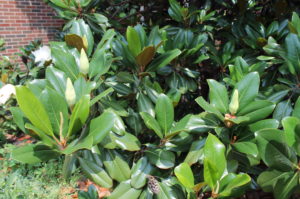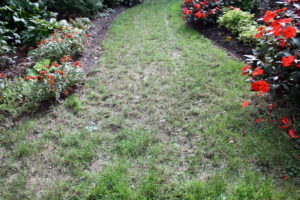I’m No Lawn Nut, But…
October 22nd, 2019
I’ve always thought that people lean too heavily on lawns, mainly because it’s the default choice when 1.) they can’t think of anything better to do with the space, or 2.) they’d rather not invest in the work and expense to do something else.
I have nothing against lawns, but unless we really want/need all of that green for play space or entertaining, there are better options (growing food, planting trees for shade, planting rain gardens to capture storm runoff, planting flowers for beauty and pollinators, etc.)
That’s why the lawn in my Cumberland County yard served mainly as pathways through the garden beds.
Now that my wife and I moved to the Pittsburgh area, we inherited an ocean of grass out front.
We’re on a corner lot with the house atop a hill, so most of the lawn is on a slope. (Everything in Pittsburgh is on a slope… or cliff.)
The magnitude of this space forced me and my rapidly aging legs to invest in a riding mower.
That’s right. I’m now a lawn guy.
If I were 35 or 40, I’d be digging up big chunks of the green to plant a Pittsburgh version of the Weigel Botanic Garden.
It’d be glorious… curving beds of shrubs and massed perennials, specimen trees, maybe a rock garden, a collection of spring bulbs, pockets of annual flowers, roses, and a dwarf conifer garden to make my wife happy.
Except for some trees and the dwarf conifer garden, that’s going to happen only in my imagination.
One problem is that I went and got old. At 63 years and counting fast, I could probably manage to create everything (with help from Mr. Ibuprofen). But a big question mark is how long I’d be able to maintain it.
A second problem is deer. The neighborhood’s four-legged, non-stop, eating machines would devour most plants as fast as I could plant them.
Read more on my new deer problem
Other than a Kousa dogwood and a few scrubby shrubs around the front foundation, the only plant I inherited in the quarter-acre grassed front yard was a half-dead blue spruce, which I just had cut down.
I hate to whack trees, but this spruce had needlecast and was bare halfway up. The remaining branches were exhibiting the tell-tale needlecast sign of heavy browning with live blue growth only at the tips.
Since a 10-foot-wide area already was grassless around the removed spruce, I replanted with a black gum ‘Wildfire’ (a native mid-sized tree with rich maroon fall foliage) and a trio of dwarf goldthread falsecypress. I finished off the bed with two triangles of ‘Caradonna’ salvia and a groundcover planting of ‘Angelina’ creeping sedum.
I’ve also added a young dawn redwood (I now have space for this eventual giant) and a weeping purple beech ‘Purple Fountain.’
Come spring, I plan to plant a Bracken’s Brown Beauty magnolia and a pair of American fringe trees – one centered out each of the front windows.
Even with those spots of color and bigger life, I still have a lot of lawn.
It’s too much to mow with a basic gas-powered push mower like I’ve always used. I tried. Then I huffed and puffed my way to the tractor dealer, where I bought a Husqvarna riding mower with a 42-inch cut.
I never thought I’d be a riding-mower guy, but here I am. It gets the job done in a quarter of the time vs. pushing. And it’s much easier on old legs.
The other challenge I face is converting the lawn from the high-input money hog that it’s been.
Past owners used lawn-care companies to fertilize and control weeds and bugs. The place came with an irrigation system, too.
My former house had a well – and a good one at that. We had no water bill. After seeing how expensive public water is out here, irrigating the lawn is out of the question… not that I was planning to use the sprinkler system anyway.
Babying the lawn with irrigation and regular chemical fertilizer translates into shallower roots and a lawn that becomes dependent on these highfalutin inputs. In other words, it doesn’t have to work very hard to get what it needs.
Grass does reasonably well with less care, but it takes time to adapt to tougher love. Take away the coddling, and the lawn protests with thinning, an infestation of weeds and crabgrass, and greater likelihood of disease.
That’s what I’ve faced this summer as I didn’t irrigate, didn’t put down crabgrass preventer, didn’t apply grub preventer, didn’t do weed-and-feed, and fertilized only twice with organic products instead of a four- or five-step chemical plan.
It doesn’t help that the soil underneath is a dreadful, compacted clay that has the sponginess of concrete after just two or three days without rain.
I’m mowing high, letting the grass clips lay, adding decent-quality grass seed, and pulling/digging weeds and crabgrass along with spot-spraying to knock down a widespread outbreak of nutsedge.
Once I build a compost bin and get the black gold that results, I’ll begin top-dressing with it. That made a huge difference over the years in my Hampden Twp. yard, but the smaller turf area made that job much more doable.
My goal here is to give the lawn only what it really needs to do reasonably well.
As the sort of corner “gatekeeper” for the neighborhood, I don’t want to just mow and end up with more weeds than grass in a few years. But I don’t need a weed-free green carpet either.
I’m shooting for what former Victory Garden host Roger Swain calls “good-enough grass.”
This lawn is going to have to learn to get by on less.










